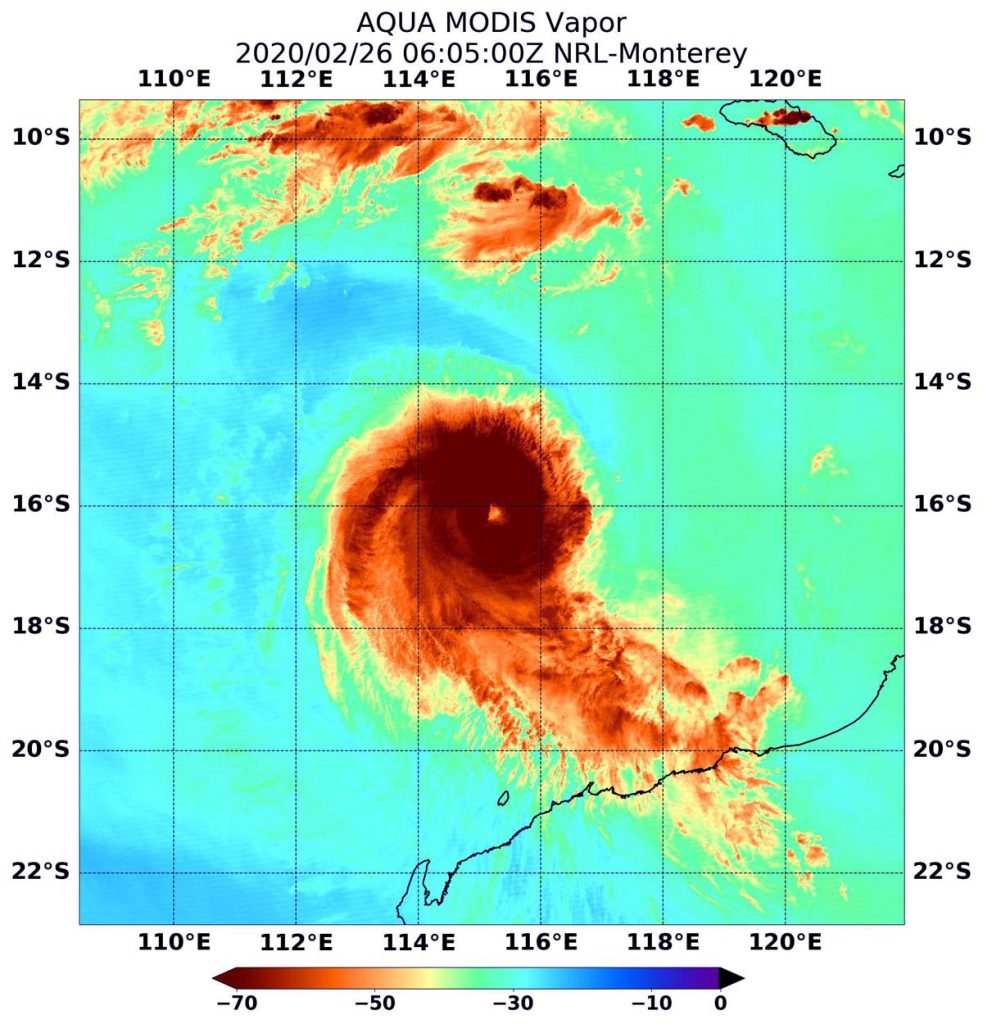Feb. 28, 2020 – NASA Finds Dry Air Sapping Tropical Cyclone Ferdinand’s Strength
When NASA’s Aqua satellite passed over the Southern Indian Ocean on Feb. 28, it obtained water vapor data on Tropical Cyclone Ferdinand. The water vapor data indicated the storm was being eaten away by dry air.
NASA’s Aqua satellite passed over Tropical Cyclone Ferdinand on Feb. 28 at 1:55 a.m. EST (0555 UTC) and the Moderate Resolution Imaging Spectroradiometer or MODIS instrument gathered water vapor content and temperature information. The MODIS image showed highest concentrations of water vapor and coldest cloud top temperatures had diminished in the last 24 hours, forming a compact area of strong storms around center of circulation. Microwave imagery even suggested an eye in the center.

The MODIS water vapor data revealed that small area of strong storms had cloud top temperatures as cold as or colder than minus 70 degrees Fahrenheit (minus 56.6 degrees Celsius). Storms with cloud top temperatures that cold have the capability to produce heavy rainfall. There was also a small fragmented band of thunderstorms northeast of the center. The imagery showed dry air moving in from west of the center quelled thunderstorm development and precipitation in the western quadrant of the storm.
Water vapor analysis of tropical cyclones tells forecasters how much potential a storm has to develop. Water vapor releases latent heat as it condenses into liquid. That liquid becomes clouds and thunderstorms that make up a tropical cyclone. Temperature is important when trying to understand how strong storms can be. The higher the cloud tops, the colder and the stronger the storms.
The Australian Bureau of Meteorology (ABM) said on Feb. 28, “Ferdinand is a small tropical cyclone located well north of the Western Australia coast.”
On Friday, February 28 at 8:00 p.m. AWST, ABM said Ferdinand had sustained winds near the center of 95 kilometers (51 knots/59 miles) per hour. Ferdinand is located near 16.2 degrees south latitude and 112.8 degrees east longitude, about 650 kilometers (404 miles) north-northwest of Onslow and 760 kilometers (472 miles) northwest of Port Hedland.
Forecasters at the ABM expect Ferdinand to move further northwest and weaken below tropical cyclone strength over the next 24 hours. The Joint Typhoon Warning Center said Ferdinand is forecast to weaken steadily due to dry air continuing to funnel into the storm, and vertical wind shear persisting. Ferdinand is forecast to dissipate by Sunday, March 1, but could dissipate earlier.
NASA’s Aqua satellite is one in a fleet of NASA satellites that provide data for hurricane research.
Tropical cyclones are the most powerful weather event on Earth. NASA’s expertise in space and scientific exploration contributes to essential services provided to the American people by other federal agencies, such as hurricane weather forecasting.
Rob Gutro
NASA’s Goddard Space Flight Center, Greenbelt, Md.




